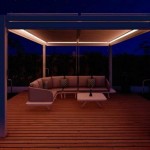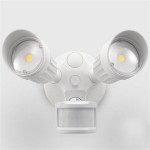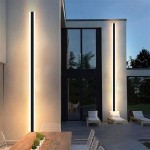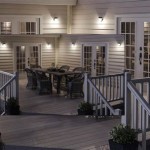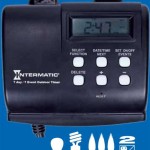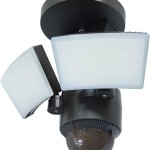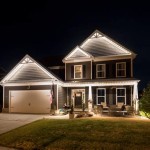Outdoor Flood Lighting Installation: A Comprehensive Guide
Outdoor flood lighting installation is a crucial aspect of property security, aesthetics, and functionality. Properly installed floodlights can deter criminal activity, enhance visibility for safe navigation, and highlight architectural features or landscaping elements. This article provides a comprehensive guide to understanding the process of outdoor flood lighting installation, covering various considerations, steps, and potential challenges.
Before embarking on any installation project, careful planning is paramount. This involves assessing the specific needs and objectives of the lighting, the characteristics of the property, and local regulations. A well-defined plan will ensure the installation is effective, safe, and compliant with all applicable codes.
Selecting the appropriate floodlights is a key determinant of the installation's success. Considerations include the type of lighting technology (LED, halogen, etc.), light output (lumens), beam angle, color temperature, and overall energy efficiency. The chosen fixtures must be suitable for outdoor use, rated for weather resistance, and compatible with the available power supply.
Safety is paramount throughout the entire installation process. Working with electricity can be hazardous, and it's crucial to take necessary precautions to avoid injury. This includes de-energizing circuits before working on them, using appropriate safety gear, and adhering to all electrical codes.
Understanding Your Lighting Needs
Prior to purchasing any materials or commencing the installation, a thorough assessment of the property's lighting requirements is essential. This involves identifying areas that need illumination and defining specific purposes for the lighting. For example, lighting might be needed to illuminate walkways for safe passage, discourage intruders from entering the property, or accentuate architectural details.
The size of the area to be illuminated is another critical factor. Larger areas will require more powerful floodlights or a greater number of fixtures to achieve adequate brightness. Understanding the desired light level in lux or foot-candles can help determine the appropriate wattage and beam angle of the floodlights.
Consider the aesthetic impact of the lighting. The color temperature of the light emitted by the floodlights can significantly alter the appearance of the property. Warmer color temperatures (around 2700-3000K) tend to create a more inviting and welcoming atmosphere, while cooler color temperatures (around 4000-5000K) provide brighter, more focused illumination.
The placement of the floodlights should also be carefully considered. Incorrect placement can result in glare, light trespass (light spilling onto neighboring properties), or inadequate illumination of desired areas. Aiming floodlights downwards and shielding them can help minimize light pollution and maximize effectiveness.
Step-by-Step Installation Process
The installation process typically involves several key steps, each requiring careful attention to detail. The following outline provides a general overview, but the specific procedures may vary depending on the type of floodlights being installed, the existing electrical infrastructure, and local building codes. It is strongly recommended to consult with a qualified electrician if there is any uncertainty about any aspect of the installation.
1. Planning and Permitting: Before starting any work, create a detailed lighting plan outlining the location of each floodlight, the wiring routes, and the control mechanisms (e.g., switches, timers, motion sensors). Check local building codes and obtain any necessary permits. Some municipalities may have restrictions on the type, placement, and brightness of outdoor lighting.
2. Safety Precautions: Always turn off the power at the circuit breaker before working on any electrical wiring. Use a voltage tester to verify that the circuit is de-energized. Wear appropriate safety gear, including safety glasses and gloves. If working at heights, use a sturdy ladder and follow all safety guidelines.
3. Mounting the Fixtures: Securely mount the floodlights to a stable surface, such as a wall, pole, or soffit. Use appropriate mounting hardware that is compatible with the fixture and the mounting surface. Ensure the fixtures are properly aligned and aimed in the desired direction.
4. Wiring the Floodlights: Connect the floodlights to the electrical circuit according to the manufacturer's instructions and local electrical codes. Use appropriately sized wiring and weatherproof connectors to ensure a safe and reliable connection. If the floodlights are being connected to an existing circuit, ensure the circuit is adequately sized to handle the additional load. Consider using a Ground Fault Circuit Interrupter (GFCI) outlet for added safety.
5. Testing and Adjustment: After the wiring is complete, carefully turn the power back on at the circuit breaker. Test each floodlight to ensure it is functioning correctly. Adjust the aim of the floodlights to optimize the illumination pattern and minimize glare. Set any timers or motion sensors according to the desired settings.
6. Final Inspection: Perform a thorough inspection of the entire installation to ensure that all connections are secure, all wiring is properly protected, and all fixtures are securely mounted. Clean up any debris and dispose of any waste materials properly.
Key Considerations and Potential Challenges
Several factors can significantly impact the success and longevity of an outdoor flood lighting installation. Addressing these considerations proactively can prevent future problems and ensure a safe and effective lighting system.
Weather Resistance: Outdoor floodlights are exposed to the elements, including rain, snow, wind, and extreme temperatures. Ensure the fixtures are rated for outdoor use and have a sufficient Ingress Protection (IP) rating to withstand the local climate. Regularly inspect the fixtures for signs of damage, such as cracks, corrosion, or water intrusion.
Electrical Codes: All electrical work must comply with local electrical codes. These codes are designed to protect property and lives by ensuring that electrical installations are safe and reliable. Consult with a qualified electrician to ensure that all work is performed in accordance with the applicable codes.
Voltage Drop: Long wiring runs can cause voltage drop, which can reduce the brightness and performance of the floodlights. Use appropriately sized wiring to minimize voltage drop. If necessary, consider using a larger gauge wire or installing a dedicated circuit for the floodlights.
Motion Sensors and Timers: Motion sensors and timers can enhance the energy efficiency and security of the lighting system. However, they can also be prone to false alarms or malfunctions. Choose high-quality sensors and timers and adjust the settings carefully to minimize these issues.
Light Trespass: Light trespass occurs when light spills onto neighboring properties, causing annoyance or disruption. Aim the floodlights downwards and shield them to minimize light trespass. Be considerate of neighbors and avoid directing light towards their homes or businesses.
Maintenance: Regular maintenance is essential for keeping the floodlights functioning properly. This includes cleaning the fixtures, replacing burnt-out bulbs (if applicable), and inspecting the wiring for any signs of damage. Schedule routine inspections and maintenance to prolong the life of the lighting system.
Professional Installation: While DIY installation may seem appealing, it's often best to hire a qualified electrician for outdoor flood lighting installation. A professional electrician has the knowledge, skills, and experience to ensure that the installation is safe, code-compliant, and effective. They can also provide valuable advice on selecting the right fixtures and designing the optimal lighting layout.

How To Install Outdoor Floodlights True Value

Comparing 3 Ways To Install Fl28 Led Flood Light Driver Box Agc Lighting

Complete Guide To Flood Lights Everything You Need Know

Commercial Led Flood Lights Manufacturer Whole

Cost To Install Exterior Lights In 2024 Checkatrade

Lepro 50w Outdoor Led Flood Light Waterproof Security For Garden Backyard Garage Etc

Dangerous Led Outdoor Floodlights

Led Floodlight 101

What Wattage Is Best For Outdoor Flood Lights Ledmyplace

Our Home From Scratch
Related Posts
